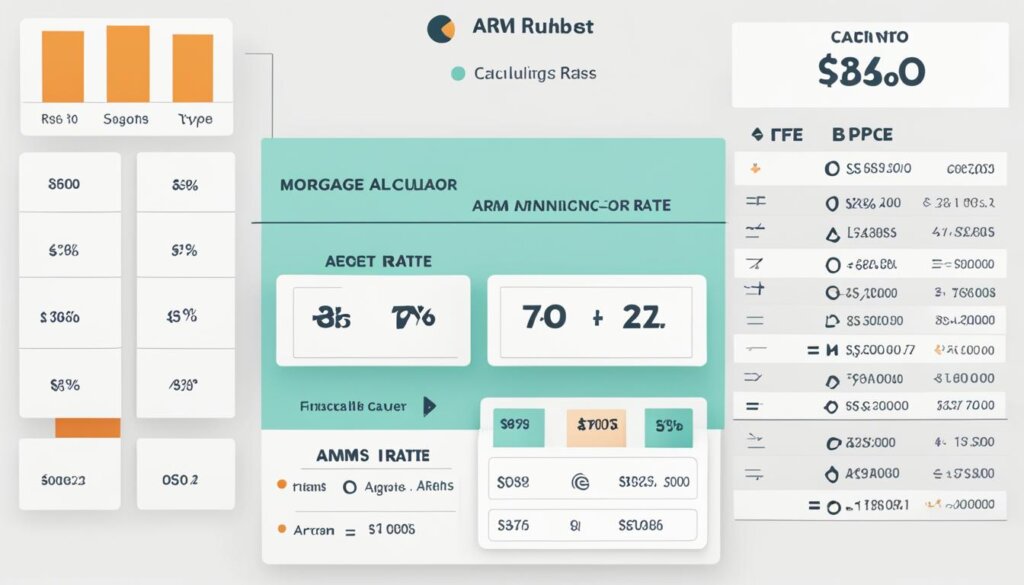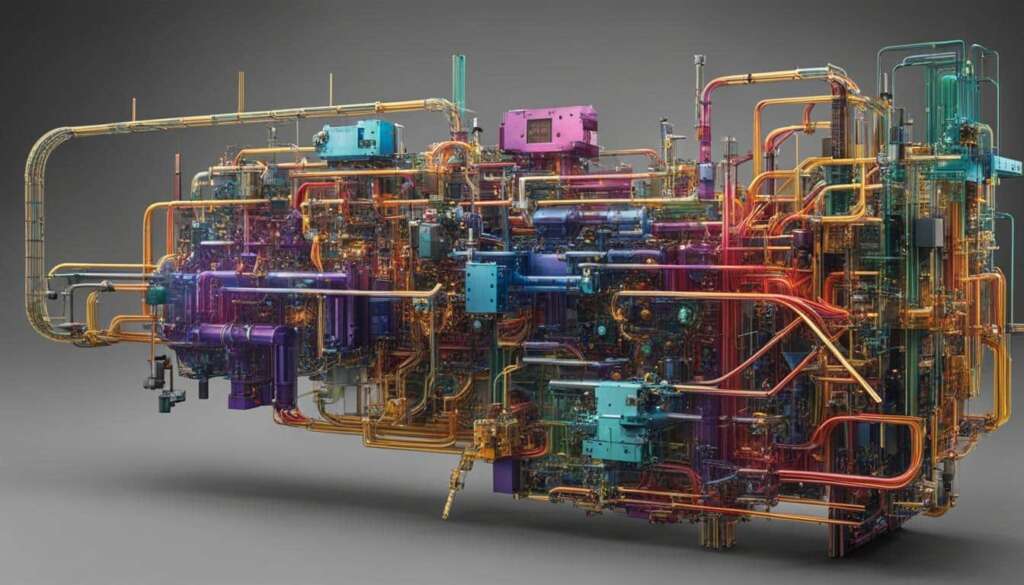Table of Contents
An adjustable-rate mortgage (ARM) is a type of home loan with a variable interest rate that can fluctuate periodically based on the performance of a specific benchmark or index. ARMs, also known as variable-rate mortgages or floating mortgages, offer borrowers the flexibility of an initial fixed interest rate for a certain period of time, after which the rate adjusts according to market conditions.
While traditional fixed-rate mortgages have a consistent interest rate throughout the loan term, ARMs allow for potential changes in interest rates. This means that the monthly payment amount can increase or decrease over time, depending on the benchmark or index.
The interest rate for ARMs is determined by adding an ARM margin to the benchmark rate, such as LIBOR or SOFR. This margin acts as a premium that lenders charge to compensate for the potential risk associated with adjustable rates.
It is important to note that ARMs come with caps that limit the maximum increase in the interest rate and/or payments per year or over the life of the loan. These caps provide borrowers with some protection against drastic rate hikes and help them plan their finances accordingly.
ARMs can be a smart financial choice for homebuyers who plan to keep the loan for a limited period of time and can afford potential increases in their interest rate. To learn more about the intricacies of adjustable-rate mortgages, continue reading the sections below.
What Is an Adjustable-Rate Mortgage (ARM)?
An adjustable-rate mortgage (ARM) is a type of home loan that has a variable interest rate. The interest rate for ARMs is based on a benchmark or index, such as LIBOR or SOFR, and is adjusted periodically, usually yearly or monthly. The initial interest rate of an ARM is fixed for a certain period, known as the fixed period or teaser rate. After the fixed period, the interest rate adjusts based on the underlying benchmark or index. ARMs are also referred to as variable-rate mortgages or floating mortgages. They have caps that limit the maximum increase in the interest rate and/or payments per year or over the life of the loan. ARMs can be a good financial choice for homebuyers who plan to keep the loan for a limited period of time and can handle potential increases in their interest rate.
When taking out an ARM, it is important for borrowers to understand the key components, such as the adjustable interest rate, the benchmark or index used to determine the rate adjustments, and the caps that protect against excessive increases. By familiarizing themselves with these aspects, borrowers can make informed decisions about their home financing options.
The interest rate on an adjustable-rate mortgage is what sets it apart from a fixed-rate mortgage. While a fixed-rate mortgage offers a consistent interest rate throughout the loan term, an ARM allows the rate to fluctuate over time, potentially resulting in lower or higher monthly payments. This variability can be both an advantage and a disadvantage, depending on the borrower’s financial situation and market conditions.
One of the key factors in determining the interest rate on an ARM is the benchmark or index it is tied to. Commonly used benchmarks include the London Interbank Offered Rate (LIBOR) and the Secured Overnight Financing Rate (SOFR). These benchmarks reflect the prevailing interest rates in the market and serve as a reference point for adjusting the ARM’s interest rate. When the benchmark rate changes, the interest rate on the ARM will adjust accordingly, either increasing or decreasing.
ARMs also come with caps that limit the amount the interest rate can increase or decrease during specified periods. These caps provide borrowers with some protection against extreme fluctuations in their monthly payments. The two types of caps typically included in an ARM are the periodic adjustment cap, which limits the change in the interest rate from one adjustment period to the next, and the lifetime cap, which sets the maximum increase over the life of the loan.
Overall, an adjustable-rate mortgage can be a suitable option for borrowers who plan to own their home for a relatively short period of time, as it offers the potential for initial lower interest rates and payments. However, it is important for borrowers to carefully consider their financial circumstances, risk tolerance, and future plans before opting for an ARM. Consulting with a mortgage professional can help borrowers evaluate whether an ARM is the right choice for their specific needs and goals.
Advantages of An Adjustable-Rate Mortgage (ARM)
- Lower initial interest rates compared to fixed-rate mortgages
- Potential cost savings, especially for short-term ownership
- Flexibility in managing future interest rate changes
Disadvantages of An Adjustable-Rate Mortgage (ARM)
- Uncertainty in future interest rate movements
- Potential for higher future payments if interest rates increase
- Complexity in understanding the terms and features of ARMs
Considering these advantages and disadvantages, borrowers should carefully weigh their options and assess their financial goals and risk tolerance when deciding between an ARM and a fixed-rate mortgage.
Types of ARMs
There are different types of adjustable-rate mortgages (ARMs) available. Each type offers distinct features and benefits to suit various financial needs. Understanding these options can help borrowers make informed decisions when choosing the right ARM for their circumstances.
Hybrid ARM
A hybrid ARM combines a fixed-rate period with an adjustable-rate period. This type of ARM is often denoted with two numbers, such as “2/28.” The first number represents the fixed-rate period, which typically lasts for a set number of years. The second number indicates the adjustable-rate period, during which the interest rate can fluctuate periodically. For example, a 2/28 ARM has a fixed rate for the first two years and then adjusts annually for the remaining 28 years.
Interest-Only ARM
An interest-only ARM allows borrowers to pay only the interest on their loan for a specific period. During this time, usually ranging from three to 10 years, borrowers make lower monthly payments as they are not required to pay down the principal amount. After the interest-only period ends, borrowers begin paying both interest and principal. This type of ARM can be ideal for individuals who anticipate increased income in the future or plan to sell their property before the principal payments begin.
Payment-Option ARM
The payment-option ARM provides borrowers with multiple payment options. They can choose to make payments covering both principal and interest, make interest-only payments, or opt for minimum payments that do not cover the full interest amount. This flexibility offers borrowers the ability to adjust their payments based on their financial situation. However, it is important to note that minimum payments may not cover the entire interest, resulting in negative amortization, where the remaining interest is added to the principal balance.
| ARM Type | Key Features |
|---|---|
| Hybrid ARM | Combines fixed-rate and adjustable-rate periods |
| Interest-Only ARM | Allows for interest-only payments for a specific period |
| Payment-Option ARM | Offers multiple payment options |
Homebuyers who are considering an ARM can use a mortgage calculator to compare the different types and determine which one aligns with their financial goals and risk tolerance.

Advantages and Disadvantages of ARMs
Adjustable-rate mortgages (ARMs) offer both advantages and disadvantages that borrowers should consider when deciding on their home loan options. Understanding these pros and cons can help individuals make informed financial decisions.
Advantages of ARMs
1. Low Rates: One of the key advantages of ARMs is their lower initial interest rates compared to fixed-rate mortgages. This can result in lower monthly payments, making ARMs an attractive option for budget-conscious borrowers.
2. Smart Financial Choice: ARMs can be a smart financial choice for borrowers who plan to keep their homes for a limited period of time. If you intend to sell or refinance within a few years, an ARM can help you take advantage of the low rates during the initial fixed period.
“ARMS can be a smart financial choice for homebuyers who plan to keep the loan for a limited period of time and can afford potential increases in their interest rate.”
3. Flexibility: ARMs offer flexibility in terms of loan duration and repayment options. Borrowers can choose from a variety of ARM terms, allowing them to align their loan with their specific financial goals and timeline.
Disadvantages of ARMs
1. Unpredictable Payments: One of the main disadvantages of ARMs is the uncertainty surrounding future interest rate changes. If market conditions lead to rate hikes, borrowers may experience an increase in their interest rate, resulting in higher monthly payments.
2. Complexity: Compared to fixed-rate mortgages, ARMs can be more complex to understand due to their various features and terms. Borrowers should carefully review the loan agreement to fully comprehend the potential risks and rewards of an ARM.
“ARMs can also be more complex to understand compared to fixed-rate mortgages, as they come with various features and terms that borrowers should be aware of.”
It is important for borrowers to carefully weigh the advantages and disadvantages of ARMs and consider their financial situation, goals, and risk tolerance. Consulting with a mortgage professional can provide further clarity and guidance in making this important decision.
How the Variable Rate on ARMs Is Determined
The variable rate on adjustable-rate mortgages (ARMs) is determined by adding the ARM margin to the ARM index rate. The ARM index rate is a benchmark rate that reflects the general state of the economy, such as the prime rate, the CMT rate, or the rate on short-term U.S. Treasuries. While the ARM index rate can change, the ARM margin remains the same throughout the loan term.
For example, if the ARM index rate is 5% and the ARM margin is 2%, the interest rate on the mortgage would be 7%. If the ARM index rate drops to 2%, the interest rate on the mortgage would be 4% based on the 2% ARM margin. The variable rate on ARMs allows for potential changes in interest rates based on market conditions.
“The variable rate on ARMs is determined by adding the ARM margin to the ARM index rate”
ARMs provide borrowers with the advantage of taking advantage of potential drops in interest rates, resulting in lower monthly payments. However, it is important to consider the possibility of the interest rate increasing, as this can lead to higher monthly payments.
ARM Index Rates
The ARM index rate, also known as the benchmark rate, is the variable component that fluctuates over time. The ARM index rate is typically influenced by economic factors and market conditions. Commonly used ARM index rates include the prime rate, which is the rate that banks charge their most creditworthy customers, and the Constant Maturity Treasury (CMT) rate, which reflects the yields on U.S. Treasury bills, notes, and bonds.
ARM Margin
The ARM margin is a fixed percentage that is added to the ARM index rate to determine the interest rate on an ARM. The ARM margin is set by the lender and remains constant throughout the loan term. The ARM margin represents the lender’s profit margin and covers the lender’s cost of funds, administrative fees, and potential risk.
It’s important for borrowers to carefully consider both the ARM index rate and the ARM margin when evaluating an adjustable-rate mortgage. By understanding how the variable rate on ARMs is determined, borrowers can make informed decisions about their mortgage options and be prepared for potential changes in interest rates.
Adjustable-Rate Mortgage vs. Fixed-Interest Mortgage
The main difference between an adjustable-rate mortgage (ARM) and a fixed-interest mortgage is in how the interest rate is set. A fixed-rate mortgage has an interest rate that remains the same throughout the loan term, offering predictable monthly payments.
On the other hand, an ARM has an interest rate that changes based on the market conditions and can result in fluctuating monthly payments.
Let’s compare the two types of mortgages:
| Fixed-Rate Mortgage | Adjustable-Rate Mortgage (ARM) |
|---|---|
| The interest rate remains stable throughout the loan term. | The interest rate can change periodically based on market conditions. |
| Monthly payments are predictable and stay the same. | Monthly payments can vary over time. |
| Provides stability and certainty for borrowers. | Offers initial lower interest rates, providing more homebuying power in the short term. |
| Borrowers have the option to refinance if interest rates in general fall, allowing them to secure a lower rate. | Interest rate adjustments are already built into the loan, eliminating the need to refinance. |
Both types of mortgages have their advantages and disadvantages. Fixed-rate mortgages are a popular choice for those who prefer stable rates and want to know their exact monthly payment amount. They also provide the opportunity to refinance if interest rates decrease.
On the other hand, ARMs can be attractive due to their initial lower interest rates, providing more homebuying power in the short term. However, borrowers should be prepared for potential interest rate changes and fluctuating monthly payments.
Ultimately, the decision between an ARM and a fixed-rate mortgage depends on individual financial goals and risk tolerance. It’s important to carefully consider the pros and cons of each option before making a decision. Consulting with a mortgage advisor can also provide valuable insights and guidance in choosing the right mortgage type for your specific needs.
Is an ARM a Good Idea?
When considering a mortgage, it’s crucial to assess whether an adjustable-rate mortgage (ARM) aligns with your specific circumstances and financial goals. ARMs can be particularly beneficial for those who plan to sell their homes or pay off their mortgages in the short term. With ARMs, borrowers can take advantage of lower initial interest rates and adjustable payments, enabling them to manage their finances more effectively.
Furthermore, if you anticipate a potential financial windfall, such as an inheritance, an ARM can provide the flexibility to benefit from the lower initial payments and then make a lump sum payment to pay off the mortgage. This can result in substantial savings in interest payments over time.
However, it’s important to be mindful of the potential risks associated with ARMs. Interest rates can fluctuate over time, leading to payment increases. To mitigate interest rate risks, borrowers should carefully budget and plan for potential payment adjustments, ensuring they can comfortably handle any future increases in monthly payments. This foresight will enable homeowners to make informed decisions and maintain their financial stability.
FAQ
What is an adjustable-rate mortgage (ARM)?
An adjustable-rate mortgage (ARM) is a type of home loan with a variable interest rate that can fluctuate periodically based on the performance of a specific benchmark or index. ARMs are also known as variable-rate mortgages or floating mortgages.
How is the interest rate determined for an ARM?
The interest rate for ARMs is determined by adding an ARM margin to the benchmark rate, such as LIBOR or SOFR. The ARM margin remains the same throughout the loan term, while the benchmark rate can change.
What are the different types of ARMs available?
There are different types of ARMs available, including hybrid ARMs, interest-only ARMs, and payment-option ARMs. Hybrid ARMs combine a fixed-rate period with an adjustable-rate period. Interest-only ARMs allow the borrower to only pay interest for a specific period before starting to pay both interest and principal. Payment-option ARMs offer several payment options to the borrower.
What are the advantages and disadvantages of ARMs?
Some advantages of ARMs include lower initial interest rates, which can result in lower monthly payments, and flexibility for short-term borrowing or financing. However, ARMs have the disadvantage of unpredictable payments because the interest rate and monthly payments can increase if market conditions lead to rate hikes. ARMs can also be more complex to understand compared to fixed-rate mortgages.
How is the variable rate on ARMs determined?
The variable rate on ARMs is determined by adding the ARM margin to the ARM index rate. The ARM index rate is a benchmark rate that reflects the general state of the economy, such as the prime rate or the rate on short-term U.S. Treasuries.
What is the difference between an ARM and a fixed-interest mortgage?
The main difference between an ARM and a fixed-interest mortgage is in how the interest rate is set. A fixed-rate mortgage has an interest rate that remains the same throughout the loan term, offering predictable monthly payments. In contrast, an ARM has an interest rate that changes based on market conditions and can result in fluctuating monthly payments.
Is an ARM a good idea?
Whether an ARM is a good idea depends on individual circumstances and financial goals. ARMs can be a good choice for individuals who plan to sell their homes or pay off their mortgages quickly. However, it is important to consider the risks associated with ARMs, such as potential payment increases due to changes in interest rates, and plan accordingly.













